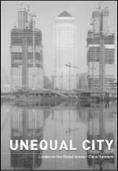culture scenarios sustainability urban design Community fabrication land use infrastructures agriculture social exclusion/integration historic centers urban africa urban renewal superplaces downtowns paesaggio innovation creativity settlements governance globalization social practices public art social housing cities
Unequal City
London in the global arena
Chris Hamnett
Unequal City examines some of the dramatic economic and social changes that have taken place in London over the last forty years. It describes how London's changing industrial structure, particularly the shift from an industrial to a services based city, and the associated changes in occupational class structure and in the structure of earnings and incomes, have worked through to the housing market and the gentrification of large parts of inner London. This has had major consequences for both the social structure and the built environment of London.
It asserts that this transformation in London's industrial structure, from a city with a large manufacturing base to one based primarily on business, financial, creative and other services, is linked to a major change in its occupational structure. But, unlike much of the literature, which argues that cities like London have become increasingly socially polarised, it argues that London has become more professionalised and has a shrinking manual workforce. The changes in the industrial and occupational structure of London have been linked to changes in its earnings and income structures. The dominant feature of London has been an expansion of its high earning groups and a marked increase in both earnings and income inequality. The growth of this expanded new middle class has had major impacts on the nature of the London housing market, particularly in the growth of home ownership, rising prices and the expansion of middle class gentrification across much of inner London. This has been paralleled by the growing marginalisation of the less skilled, the unemployed and various minority groups in the council sector. These changes have reshaped the social structure and social geography of London. They have made it a more unequal city.
Unequal City relates to the literature on global cities. The book has a wide sweep and summarises a wide range of literature on occupational and industrial change, earnings and incomes and the housing market and gentrification. It provides a wealth of original data, figures, maps and tables and will be a valuable reference for anyone interested in the changes that have reshaped the social structure of London in recent decades.
CONTENTS
List of Plates
List of Figures
List of Tables
Acknowledgements
1. Introduction:the remaking of London
2. The economy of London:from industrial to post-industrial city
3. The transformation of Lodon's occupational structure and the rise of the new middle class
4. Widening inequality:earnings and incomes
5. Multi-ethnic Lodon:migration, race and ethnicity
6. The transformation of the housing market
7. Gentrification and the middle-class remaking of Inner London
8. Deprivation, social exclusion and its consequences
9. Remaking the landscape:from industrial to post-industrial city
Bibliography
Index




Planum
The Journal of Urbanism
ISSN 1723-0993
owned by
Istituto Nazionale di Urbanistica
published by
Planum Association
ISSN 1723-0993 | Registered at Court of Rome 4/12/2001, num. 514/2001
Web site realized by ChannelWeb & Planum Association | Powered by BEdita 3

